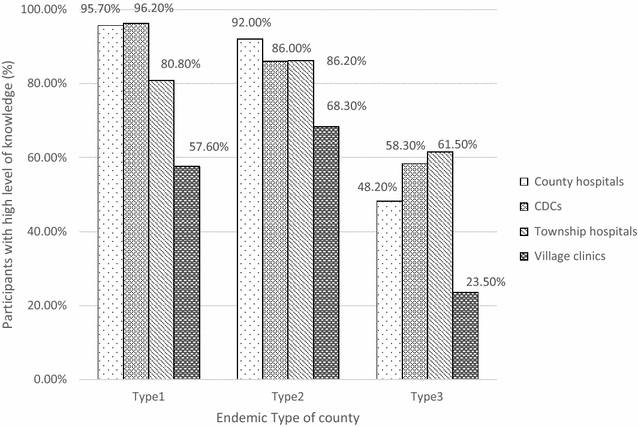Improving local health workers' knowledge of malaria in the elimination phase-determinants and strategies: a cross-sectional study in rural China
- PMID: 28526083
- PMCID: PMC5438496
- DOI: 10.1186/s12936-017-1865-1
Improving local health workers' knowledge of malaria in the elimination phase-determinants and strategies: a cross-sectional study in rural China
Abstract
Background: The current stage of malaria elimination in China requires experienced local health workers with sufficient knowledge of malaria who help to keep the public health system vigilant about a possible resurgence. However, the influencing factors of local health workers' knowledge level are not fully comprehended. This study aims to explore the factors with heavy impact on local health worker's knowledge of malaria and propose corresponding suggestions.
Methods: Underpinned by stratified sampling method, a cross-sectional survey was carried out between November 2014 and April 2016. Chi square test was performed to identify the factors with potential influence on health workers' knowledge level of malaria. Bivariate logistic regression was employed to explore the relationship between the predictors and local health workers' knowledge level of malaria. Layered Chi square test was used to calculate the homogeneity of the interaction between training approaches and the percentage of participants with high-level knowledge.
Results: The endemic type of county and type of organization played the most significant role in influencing local health workers' knowledge level regarding malaria in the sample population. The participants from Type 1 and Type 2 counties were 4.3 times (4.336 and 4.328, respectively) more likely to have high-level knowledge of malaria than those who work in Type 3 counties. The probability of having high-level knowledge amongst the participants from county-level facilities (county hospitals and CDCs) were more than 2.2 times higher than those who work in villages. Other socio-demographic factors, such as education and work experience, also affected one's knowledge regarding malaria. Amongst the six most-used training approaches, electronic material (OR = 2.356, 95% CI 1.112-4.989), thematic series (OR = 1.784, 95% CI 0.907-3.508) and supervision (OR = 2.788, 95% CI 1.018-7.632) were proven with significant positive impact on local health workers' knowledge of malaria.
Conclusion: Village doctors and who served in Type 3 counties were identified as the ones in urgent need of effective training. Three types of training approaches, including electronic material, thematic series and supervision, were proven to be effective in improving local health workers' knowledge. Nevertheless, the coverage of these training approaches was still limited. This study suggests expanding the coverage of training, especially the three particular types of training, to local health workers, particularly to the target populations (village doctors and who served in Type 3 counties). Online training, small group discussion and targeted skill development may be the directions for the future development of training programmes.
Keywords: Influencing factors; Knowledge level; Local health workers; Malaria.
Figures
Similar articles
-
Determinants of public malaria awareness during the national malaria elimination programme: a cross-sectional study in rural China.Malar J. 2016 Jul 19;15(1):372. doi: 10.1186/s12936-016-1427-y. Malar J. 2016. PMID: 27430322 Free PMC article.
-
Public awareness of malaria in the middle stage of national malaria elimination programme. A cross-sectional survey in rural areas of malaria-endemic counties, China.Malar J. 2016 Jul 19;15(1):373. doi: 10.1186/s12936-016-1428-x. Malar J. 2016. PMID: 27436087 Free PMC article.
-
Factors influencing health workers' compliance with outpatient malaria 'test and treat' guidelines during the plateauing performance phase in Kenya, 2014-2016.Malar J. 2022 Mar 3;21(1):68. doi: 10.1186/s12936-022-04093-x. Malar J. 2022. PMID: 35241074 Free PMC article.
-
Barriers and facilitators to healthcare workers' adherence with infection prevention and control (IPC) guidelines for respiratory infectious diseases: a rapid qualitative evidence synthesis.Cochrane Database Syst Rev. 2020 Apr 21;4(4):CD013582. doi: 10.1002/14651858.CD013582. Cochrane Database Syst Rev. 2020. PMID: 32315451 Free PMC article.
-
Preferences for training needs of village doctors in China: a systematic review.Fam Pract. 2024 Dec 2;41(6):874-882. doi: 10.1093/fampra/cmad063. Fam Pract. 2024. PMID: 37300310
Cited by
-
Do we need to go further to train healthcare providers in the targeted regions for malaria elimination in Myanmar? A mixed-methods study.Trop Med Health. 2020 Feb 21;48:11. doi: 10.1186/s41182-020-00196-w. eCollection 2020. Trop Med Health. 2020. PMID: 32123518 Free PMC article.
-
Distribution of malaria patients seeking care in different types of health facilities during the implementation of National Malaria Elimination Programme.Malar J. 2020 Mar 30;19(1):131. doi: 10.1186/s12936-020-03205-9. Malar J. 2020. PMID: 32228594 Free PMC article.
-
Knowledge and practices regarding malaria and the National Treatment Guidelines among public health workers in Equatorial Guinea.Malar J. 2021 Jan 7;20(1):21. doi: 10.1186/s12936-020-03528-7. Malar J. 2021. PMID: 33413402 Free PMC article.
-
Malaria training for community health workers in the setting of elimination: a qualitative study from China.Malar J. 2018 Feb 23;17(1):95. doi: 10.1186/s12936-018-2229-1. Malar J. 2018. PMID: 29475439 Free PMC article.
-
An economic analysis of malaria elimination program in Nepal.Heliyon. 2020 May 3;6(5):e03886. doi: 10.1016/j.heliyon.2020.e03886. eCollection 2020 May. Heliyon. 2020. PMID: 32395658 Free PMC article.
References
-
- WHO. World Malaria Report 2015. Geneva: World Health Organization; 2015.
Publication types
MeSH terms
LinkOut - more resources
Full Text Sources
Other Literature Sources
Medical
Miscellaneous


